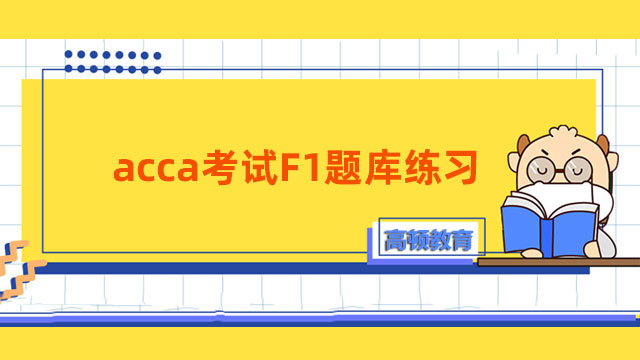ACCA考试P1-P3模拟题及解析6
来源:
高顿网校
2014-07-16
以下是高顿网校小编为学员整理的:ACCA P1-P3模拟题及解析。
In Yaya Company, operations director Ben Janoon recently realised there had been an increase in products failing the final quality checks. These checks were carried out in the QC (quality control) laboratory, which tested finished goods products before being released for sale. The product failure rate had risen from 1% of items two years ago to 4% now, and this meant an increase of hundreds of items of output a month which were not sold on to Yaya’s customers. The failed products had no value to the company once they had failed QC as the rework costs were not economic. Because the increase was gradual, it took a while for Mr Janoon to realise that the failure rate had risen.
A thorough review of the main production operation revealed nothing that might explain the increased failure and so attention was focused instead on the QC laboratory. For some years, the QC laboratory at Yaya, managed by Jane Goo, had been marginalised in the company, with its two staff working in a remote laboratory well away from other employees. Operations director Ben Janoon, who designed the internal control systems in Yaya, rarely visited the QC lab because of its remote location. He never asked for information on product failure rates to be reported to him and did not understand the science involved in the QC process. He relied on the two QC staff, Jane Goo and her assistant
John Zong, both of whom did have relevant scientific qualifications.
The two QC staff considered themselves low paid. Whilst in theory they reported to Mr Janoon, in practice, they conducted their work with little contact with colleagues. The work was routine and involved testing products against a set of compliance standards. A single signature on a product compliance report was required to pass or fail in QC and these reports were then filed away with no-one else seeing them.
It was eventually established that Jane Goo had found a local buyer to pay her directly for any of Yaya’s products which had failed the QC tests. The increased failure rate had resulted from her signing products as having ‘failed QC’ when, in fact, they had passed. She kept the proceeds from the sales for herself, and also paid her assistant, John Zong, a proportion of the proceeds from the sale of the failed products.
Required:
(a) Explain typical reasons why an internal control system might be ineffective. (5 marks)
(b) Explain the internal control deficiencies that led to the increased product failures at Yaya. (10 marks)
(c) Discuss the general qualities of useful information, stating clearly how they would be of benefit to Mr Janoon,and recommend specific measures which would improve information flow from the QC lab to Mr Janoon.(10 marks)
(25 marks)
Answer:
(a) Ineffective internal controls.
Well designed IC systems can be ineffective for a number of reasons.
Costs outweighing benefits. This is when an IC system provides poor value for money or it provides more assurance than is needed (i.e. the control is over-specified). In such a situation, the control will not be supported or trusted by those working alongside or within the control, and this will reduce its effectiveness.
Failures in human judgement when assessing a control, or fraud in measuring or reporting a control. Where a control relies upon human measurement, error is always a possibility either through lack of training, incompetence, wilful negligence or having a vested interest in control failure (such as with Jane Goo, who believed she could gain financially by a product failing to pass successfully through a quality control standard).
Collusion between employees, perhaps with a vested interest in misapplying or circumventing a control. The risk of this is greater when two or more people believe they may gain by it. It could be, for example, a sales team misquoting sales figures against a budget or directors misreporting accounting data to increase their bonuses or maintain a higher share price before
exercising share options. The collusion between Jane Goo and John Zong (who received part of the payment) was one of the factors that may have led to the failure of QC controls being effective at Yaya.
Non-routine or unforeseen events can render controls ineffective if they are intended to monitor a specific process only. Most internal controls are unable to cope with extraordinary events and so need to be adapted or circumvented when such events occur.
Previous or existing controls can become obsolete because they are not updated to meet changed conditions. A control introduced to monitor a process or risk that has changed, reduced or been discontinued will no longer be effective. Changes to key risks, for example, need to modified if they are to continue to remain effective in controlling the risk.
(b) IC deficiencies at Yaya.
Jane Goo was fraudulently entering compliance reports with no-one required to countersign them or confirm her checks.
The system did not require a second signature and no-one saw the product compliance reports after completion, so Jane had no one to review, confirm and assure that her QC measurements were true or accurate. She believed herself to be poorly paid and this may have increased the incentives for her to carry out the deceit. Additionally, it appears she was left to ‘destroy’ the goods that failed QC, allowing her to sell the goods externally. Segregating the disposal of the goods from the creation of the reports would also have helped prevent this fraud occurring.
Linked to this, there was collusion between Jane Goo and John Zong, who received part of the proceeds for his complicity in the fraud. This meant that the both of the people in the QC department were involved and the isolation of the laboratory made the discovery of their activities less likely.
There was no control capable of automatically signalling to management that the failure rate had increased. The fact that the rate rose gradually and not in a steep change seems to have made the change less visible, but a maximum acceptable failure rate with an appropriate measurement system would have triggered a signal to management that the rate had risen above it.
The way the QC department was viewed by the company meant that its activities would have received less scrutiny than other parts of the business. The QC department was marginalised and located away from other activities and the combination of these factors made it unlikely that they would often be disturbed. The fact that there was no automatic reporting link between QC and Mr Janoon was perhaps symptomatic of the marginalisation and this contributed to the problem.
The operations director Ben Janoon was negligent as a manager and had little control over the process. He rarely visited the QC lab, failed to monitor product failure rates, and failed to spot a fourfold increase in product failure rates. It was he that designed the system and with such a large number of weaknesses in the system, he must bear some of the responsibility for the lack of control, if not for the actual fraud itself.
(c) General qualities of information specific measures.
Qualities of useful information to Mr Janoon Useful information has a number of general qualities that distinguishes it from less-than-useful information. This is a very important element of an internal control system, as evidenced by a lack of information flow to Ben Janoon at Yaya Company.
Information flowing to Mr Janoon should be relevant, reliable, timely, understandable and cost-beneficial.
Relevant means that anything that Jane Goo feels should be brought to Mr Janoon’s attention should be included in the information. Any changes to the overall quality of finished goods should be voluntarily reported, for example, any issues that would prevent the QC lab performing its important function or any changes to product failure rates.
Reliable refers to the trustworthiness of the information and whether or not it is a faithful representation of what is being conveyed. It concerns the assumption that it is ‘hard’ information, that it is complete, correct, that it is impartial, unbiased, accurate and complete. Mr Janoon needs to know that the information he receives from Jane Goo is a true reflection of what is actually the case in the QC lab and that, for example, the reported failure rates are not understated for her personal gain.
Timely refers to the fact that information has a time value. Information that is late, for example, may be completely useless to the receiver. Information should arrive so that it can be processed effectively by the receiver and used for decision-making as it was intended.
Mr Janoon does not understand the science behind the QC processes and it is therefore important that any information from the QC lab is understandable by him. Because Jane Goo and John Zong had relevant scientific qualifications, it was important that information fed to Mr Janoon was free of jargon and in a form that is meaningful to him as a non-scientist.
Cost beneficial means that the cost incurred to generate the information does not outweigh its benefit. Simple reports on QC compliance at Yaya would probably be very cost-beneficial, for example, but in other situations, special reports can be expensive to produce and have little consequence to end users. [Tutorial note: other approaches to this answer may also be taken.]
Specific information-flow measures
Mr Janoon could receive more frequent reports, maybe weekly or monthly, on QC failure rates. The fact that two years went by without him noticing the increased failure indicated that he had no effective information flow on the problem. A reliable flow of key QC metrics would enable him to plot these metrics over time, thereby highlighting any changes over time.
Providing a predetermined format for Jane Goo to complete would ensure that he obtained the necessary information and it would place the information flow in his hands rather than with Jane Goo.
The information he receives could be of a higher quality, with more detail and possibly ‘drilled down’ data on product compliance against specific metrics. The ‘drilled down’ data would have detected the fact that Jane Goo had failed products that should, according to the product specification, have passed, and this could also have detected the fraud earlier.
Regular routine physical contact with QC employees, especially the QC manager. The fraud was partly caused by the environment within Yaya that saw QC as marginal and inconvenient, and partly by Jane Goo, believing that her work was unaccountable and unmonitored. By moving the QC lab closer to the main operations or establishing a clearer formal reporting regime from the QC manager to the operations director, the quality of information flows would be improved, and opportunity
for fraud diminished.
高顿网校小编寄语:自信是成功的先决条件。

扫一扫微信,*9时间获取2014年ACCA考试报名时间和考试时间提醒
高顿网校特别提醒:已经报名2014年ACCA考试的考生可按照复习计划有效进行!另外,高顿网校2014年ACCA考试辅导高清课程已经开通,通过针对性地讲解、训练、答疑、模考,对学习过程进行全程跟踪、分析、指导,可以帮助考生全面提升备考效果。
报考指南:2014年ACCA考试备考指南
免费题库:2014年ACCA考试免费题库
考前冲刺:ACCA备考秘籍
高清网课:ACCA考试网络课程
报考指南:2014年ACCA考试备考指南
免费题库:2014年ACCA考试免费题库
考前冲刺:ACCA备考秘籍
高清网课:ACCA考试网络课程
版权声明:本条内容自发布之日起,有效期为一个月。凡本网站注明“来源高顿教育”或“来源高顿网校”或“来源高顿”的所有作品,均为本网站合法拥有版权的作品,未经本网站授权,任何媒体、网站、个人不得转载、链接、转帖或以其他方式使用。
经本网站合法授权的,应在授权范围内使用,且使用时必须注明“来源高顿教育”或“来源高顿网校”或“来源高顿”,并不得对作品中出现的“高顿”字样进行删减、替换等。违反上述声明者,本网站将依法追究其法律责任。
本网站的部分资料转载自互联网,均尽力标明作者和出处。本网站转载的目的在于传递更多信息,并不意味着赞同其观点或证实其描述,本网站不对其真实性负责。
如您认为本网站刊载作品涉及版权等问题,请与本网站联系(邮箱fawu@gaodun.com,电话:021-31587497),本网站核实确认后会尽快予以处理。
点一下领资料
【整理版】ACCA各科目历年真题
真题高频考点,刷题全靠这份资料
下载合集
acca全科学习思维导图
梳理核心考点,一图看懂全部章节
下载合集
2023年acca考纲解析
覆盖科目重难点,备考按照计划走
下载合集
acca备考 热门问题解答
- acca考试怎么搭配科目?
-
建议优先选择相关联的科目进行搭配报考,这样可以提高备考效率,减轻备考压力,1、F1-F4:为随时机考科目,难度较低,这里可以自行随意选择考试顺序。2、F5-F9:如果你的工作的和财务会计或者审计有关、或者你比较擅长财务和审计的话,推荐先考F7和F8。你可以选择一起考ACCA考试科目F7和F8或者先考F7(8)再考F8(7),这就要取决你一次想考几门。3、P阶段:选修科目中,建议企业首选AFM!第二部分科目进行选择,如果AA和SBR掌握学生更好,可以通过选择AAA,如果SBL掌握的好,可以自己选择APM。
- acca一共几门几年考完?
-
acca一共有15门考试科目,其中有必修科目和选修科目,考生需要考完13门科目才能拿下证书。
- acca一年考几次?
-
acca一年有4次考试,分别是3月、6月、9月和12月,分季机考科目是采取的这类四个考季的模式,而随时机考则是没有这方面的时间规定限制,可以随报随考。
- acca的含金量如何?
-
ACCA证书的含金量是比较高的,从就业、能力提升、全球认可等角度来说,都是比较有优势的证书,其含金量主要表现在以下几个方面:1、国际化,认可度高;2、岗位多,就业前景好;3、缺口大,人才激励。
严选名师 全流程服务
其他人还搜了
热门推荐
-
acca考试F1题库练习,考生必备! 2023-03-20
-
acca2022真题下载流程介绍,必做考前模考题! 2023-02-24
-
ACCA试卷出题形式?ACCA考试最快多久能通过? 2021-07-24
-
ACCA官方样题 F4(ENG) F8 2021-01-07
-
ACCA考试P1-P3模拟题及解析9 2021-01-07
-
四大会计事务所2017年终精华会评(中) 2018-02-01
-
2016年ACCA F1模拟练习题及答案 2016-02-29
-
2016年ACCA F8每日一练:Professional ethics 2016-01-26
-
2016ACCA考试F8自测题:Corporate governance 2016-01-26
-
关于ACCA考试P7中的专业和道德问题 2015-11-24
-
ACCA P5精选模拟题之战略性绩效考核 2015-10-10
-
ACCA F9模拟测试题之投资评估 2015-10-10
-
ACCA P3精选练习题之战略管理和组织变革 2015-10-10
-
2014年ACCA《公司法与商法》真题及答案七 2015-07-20
-
2014年ACCA《公司法与商法》真题及答案七 2015-07-20
-
2014年ACCA《公司法与商法》真题及答案六 2015-07-20
-
2014年ACCA《公司法与商法》真题及答案五 2015-07-20
-
2014年ACCA《公司法与商法》真题及答案四 2015-07-20
-
2014年ACCA《公司法与商法》真题及答案三 2015-07-20
-
2014年ACCA《公司法与商法》真题及答案二 2015-07-20
-
2014年ACCA《公司法与商法》真题及答案一 2015-07-20
-
2014年ACCA《公司法与商法》真题及答案八 2015-07-20
-
2015年ACCA考试模拟题 2015-06-26
-
2015年ACCA考试精选测试题汇总 2015-06-19
-
2015年ACCA考试《财务成本管理》模拟题汇总 2015-06-18
-
2015年ACCA考试F8模拟试题:Financial Management 2015-06-18
-
ACCA考试2015年《财务成本管理》模拟练习汇总 2015-04-27
-
ACCA考试2015年《财务成本管理》模拟练习5 2015-04-27
-
ACCA考试2015年《财务成本管理》模拟练习4 2015-04-27
 更多服务
更多服务

















